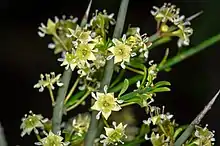| Adolphia californica | |
|---|---|
 | |
| Scientific classification | |
| Kingdom: | Plantae |
| Clade: | Tracheophytes |
| Clade: | Angiosperms |
| Clade: | Eudicots |
| Clade: | Rosids |
| Order: | Rosales |
| Family: | Rhamnaceae |
| Genus: | Adolphia |
| Species: | A. californica |
| Binomial name | |
| Adolphia californica | |
Adolphia californica, known by the common names California adolphia, California prickbush, and spineshrub, is a species of flowering shrub in the buckthorn family.[1]
Distribution
The shrub is native to the coastal plains and Peninsular Ranges foothills in northwestern Baja California and San Diego County in Southern California.[1]
It is found in chaparral and coastal sage scrub plant communities, at elevations below 400 metres (1,300 ft).[1]
Description
Adolphia californica is a branching shrub not exceeding 1 metre (3.3 ft) in height.[1]
It has thick hairless to fuzzy dark green twigs. The stiff twigs bear sharp thorns. The very sparse leaves are each less than a centimeter long and oval-shaped with a pointed or rounded tip.
The shrub blooms abundantly in clusters of flowers along all the branches. Each flower is a star-shaped bowl of five pointed cream-colored sepals. Between the sepals are five tiny spoon-shaped cream-colored petals. The bloom period is December to April.[1]
The fruit is a spherical capsule about half a centimeter across.
Conservation
Within California Adolphia californica is a Critically endangered species, listed by the California Native Plant Society on the Inventory of Rare and Endangered Plants.[2] It is threatened by urbanization, road construction, non-native plants, and grazing.[2]